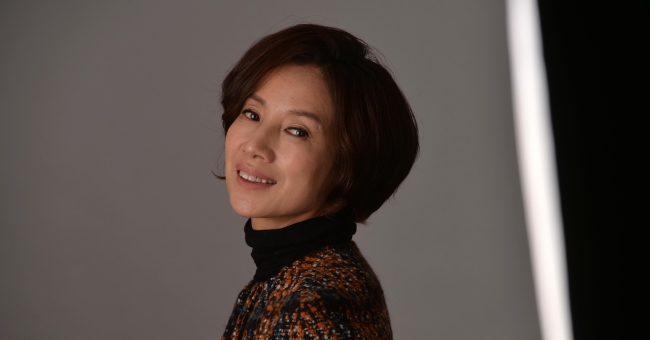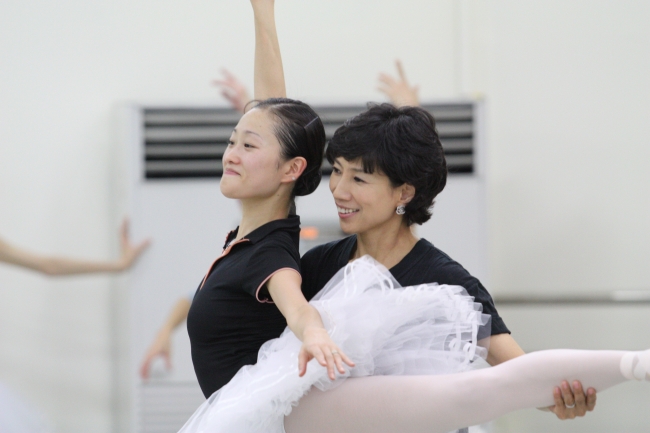A life devoted to ballet
Korean National Ballet’s long-time artistic director Choi Tae-ji shares her life and career in her last month as the troupe’s head
By Claire LeePublished : Dec. 20, 2013 - 19:58

In 1996, at the age of 37, Choi Tae-ji was appointed the new director of the Korean National Ballet. The Japanese-born ballet dancer did not have much experience in administrative affairs, spoke Korean with difficulty, and was the youngest person ever to serve in the position.
She hung up her pointe shoes and never looked back; her life in suits and high heels began.
Now 54, Choi is in her last month as the company’s artistic director, after spending a total of 12 years as its head. Her first term lasted from 1996 to 2001, and her second began in 2008. Under her direction, the Korean National Ballet saw extraordinary growth.
The troupe, which only had about 40 dancers and 60 performances in 2000, now boasts 90 dancers and holds about 120 shows a year. Choi convinced Russia’s famed choreographer Yury Grigorovich to have his versions of “Swan Lake,” “The Nutcracker” and “Spartacus” performed in Korea by her dancers.
It was also during her tenure that the nation saw the rise of star ballerinas, such as Kim Ji-young and Kim Joo-won. The attendance for the company’s performances reached 90 percent of capacity last year, a huge improvement from the 67 percent in 2008.
“I loved ballet very much, yes. There is no doubt about that,” Choi said in an interview with The Korea Herald.
“But at the same time, I tried really hard to run away from it a number of times. I wanted to be a good housewife and a mother before being appointed the troupe’s director in 1996. I accepted the position mainly because Im Seong-nam, the founding director of the company, consistently persuaded me.
“And having lived overseas for many years, I was very grateful that I was wanted and needed somewhere,” she continued.
“And I was also well aware of all the challenges and problems faced by the troupe’s dancers, because I used to be one of them. So it wasn’t exactly just because of my love for ballet. I did it because of and for the people I knew.”
Ballet with commentary
Though ballet enjoys unprecedented popularity today, things weren’t the same in the late 1990s. Choi remembers the general audience often saying that ballet is “very boring” and “too difficult to understand.” In response, she created “Ballet with Commentary” in 1997, one of her best-known projects, which combined verbal explanations by dancers and choreographers along with ballet performances. The program, which is still performed regularly today, was a huge hit ― contributing to the popularization of ballet.
“Actually, the primary purpose of ‘Ballet with Commentary’ was to have the dancers perform as many times as possible,” Choi said.
“I didn’t want them to just practice in studios all the time. I still think dancers should spend as much time as possible on stage. I wanted to give them more opportunities to meet the audience. So I took them anywhere and everywhere to perform, as long as there was an audience waiting and the stage floor wasn’t slippery. We would perform in department stores and even outdoors. We had a lot of fun.”
Japan to Seoul
Born in Kyoto to ethnic Korean parents, Choi, whose Japanese name was Yasue Otani, grew up admiring Hollywood movie stars, such as Vivien Leigh, Audrey Hepburn and Julie Andrews. “I loved how they seemed so confident and sophisticated in their movies,” Choi said. “And I came to like ballet as a child because my ballet teacher was the most sophisticated looking person I’d ever seen. And later, I liked how I could play all these confident characters, such as the black swan, and Kitri in ‘Don Quixote,’ through ballet.”
Choi is known for her fun and approachable personality, on top of her focus and enthusiasm. “When I was a child, I was told by my teacher that I should become a comedian,” Choi said. “I just liked to be around a lot of people and it was even better if they were happy. I didn’t like fights and conflicts.”
But being a young ballet dancer often isolated her. Choi started taking ballet classes at age 9, and it often required her to “live like a gypsy,” she said. She was often excluded by her fellow young dancers for being the “teacher’s favorite,” and had to spend much time alone although that was the last thing she wanted. “That’s why I thought I would quit ballet once I get married,” Choi said.
Her life changed dramatically in 1981, when she was selected as one of the recipients of a Japanese government scholarship to study overseas, only to have it canceled shortly afterward because of her Korean nationality.
“It was like a blackout,” Choi said. “I was very, very sad. And it was very shocking. Ballet was what made me feel confident about myself, and the fact that I lost the opportunity to do more of it only because of my nationality was just very discouraging. I thought: how am I going to live in Japan from now on? I never thought about my identity as a Korean too seriously up until that point.”
Choi arrived in Seoul in 1983 to join the Korean National Ballet. The company’s founding director, Im Seong-nam, had once been taught by Hiroshi Shimada, who served as the head of the Japan Ballet Association. It was Shimada, also an ethnic Korean living in Japan, who suggested Choi meet Im and dance for the Korean National Ballet. Choi barely spoke Korean at the time, and hardly knew anyone in Seoul. “My parents always missed Korea very much,” Choi said. “They were very proud that I was dancing for Korea’s national dance company. It really meant a lot to them.”
A mother, a woman
Leaving the troupe after being its head for 12 years, Choi said she has no regrets, except her work-life balance. While working as the troupe’s head, which “required her to be on call 24/7,” Choi said she was “too busy” to miss the life she left in Japan. She couldn’t be there for her parents when they passed away. Choi also wasn’t able to spend enough time with her two daughters. Her late husband abruptly passed away in April this year.

“You know, when I was first appointed for this job, I had this instinctive feeling that I will have a hard time because of ballet,” Choi said. “It was like a hunch. I felt like I will end up sacrificing a lot for this job, or end up being unhappy in my personal life. Dancers only have to dance well. Dance teachers only have to teach well. But being the head of KNB required you to be an all-rounder.
“When I was in my late 20s, many people told me that a woman has to sacrifice about 50 percent of their personal and professional desires when they get married, and give up their 100 percent once they have a child,” she continued.
“But I didn’t believe in it. I was confident that I could be an exception. But keeping my work-life balance became very difficult after being appointed as the director of KNB. There are many things I missed out as a woman and a mother. So one could say I’ve been unhappy as an individual, but c’est la vie.”
To dream again
As the head of the troupe, Choi emphasized to her dancers the importance of being a good person, on top of being a good dancer. Discipline was also an important factor. Once, one of the dancers left the shared studio messy, leaving his or her shoes on the floor. Choi threw the shoes out.
“The point is that as a dancer, you are a human being, not a machine,” Choi said. “And people are not moved by looking at machines. And as a person, what you do offstage inevitably shows onstage. You can’t trick the audiences. They just know. So that is why you need to be a good person in order to be a good dancer.”
Choi said the first thing she wants to do next month, after her term ends, is to rest and spend as much time with her daughters, both of whom are in their 20s.
“But I also want to dream something new, although I don’t know what it is,” Choi, who said she would’ve been happy as a secretary at a big firm ― she does not enjoy leadership roles and enjoys handling ordered tasks, Choi said ― if she had never started ballet, said.
“I used to think that once I left the Korean National Ballet, my career would be over. But I am now motivated to discover new things and strive to achieve something that I didn’t know before.”
By Claire Lee (dyc@heraldcorp.com)












![[Today’s K-pop] BTS pop-up event to come to Seoul](http://res.heraldm.com/phpwas/restmb_idxmake.php?idx=644&simg=/content/image/2024/04/17/20240417050734_0.jpg&u=)




![[KH Explains] Hyundai's full hybrid edge to pay off amid slow transition to pure EVs](http://res.heraldm.com/phpwas/restmb_idxmake.php?idx=652&simg=/content/image/2024/04/18/20240418050645_0.jpg&u=20240419100350)

![[Today’s K-pop] Zico drops snippet of collaboration with Jennie](http://res.heraldm.com/phpwas/restmb_idxmake.php?idx=642&simg=/content/image/2024/04/18/20240418050702_0.jpg&u=)